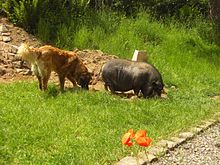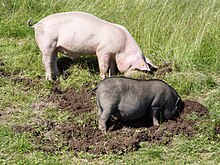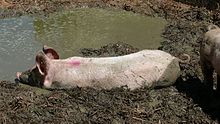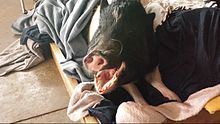Talk:Miniature pig
A fact from Miniature pig appeared on Wikipedia's Main Page in the Did you know column on 31 May 2009 (check views). The text of the entry was as follows:
|
| This article is rated C-class on Wikipedia's content assessment scale. It is of interest to the following WikiProjects: | |||||||||||
| |||||||||||
Untitled
[edit]The introduction contradicts itself, referring to micropigs as a breed in the first sentence, then saying that micro pigs are not a distinct breed. — Preceding unsigned comment added by 188.141.52.67 (talk) 20:47, 13 March 2017 (UTC)
"Notable" references
[edit]How can a pig be used "So that Lily could learn to reject her old high-school boyfriend Scooter". Without explanation that sentence is meaningless. It is probably not a "notable reference" either, so I suggest deletion. — Preceding unsigned comment added by 124.197.15.138 (talk) 20:41, 4 February 2012 (UTC)
Sidebar
[edit]Country of origin is Europe? — Preceding unsigned comment added by 174.100.41.34 (talk) 11:08, 7 June 2012 (UTC)
This article is terrible
[edit]Can someone re-write this entire article? It's completely awful. 24.186.30.227 (talk) 03:05, 11 November 2012 (UTC)
- Yes, this article needs reliable sources and some of the wording needs to be rephrased.184.0.18.29 (talk) 18:09, 29 December 2012 (UTC)
- Agreed — Preceding unsigned comment added by 74.73.239.126 (talk) 19:16, 31 December 2012 (UTC)
Disputed
[edit]Misinformation all over the place, especially in the "Facts" section which gives no sources and appears to have been written by a "mini-pig" seller. Numerous online sources and pig rescue organizations such as those here: http://lilorphanhammies.org/ http://www.teacuppig.info http://www.petpigs.com/ http://www.teacuppig.info/Pig_Sanctuaries.html attest that there is no recognized breed of "teacup pig" and that the pigs sold as such are really just smaller pot-bellied pigs, which when properly fed reach upwards of 200 lbs. The "Facts" section is actively harmful in that it encourages people to buy an animal which they may not have the resources or knowledge to properly raise. --67.183.17.4 (talk) 11:50, 3 February 2013 (UTC)
- FWIW, I can't find a single story (either news article or personal account) about a "teacup pig" or any other breed of pig that stayed under 60lbs when over 4 years old - several rescue sites mention that such animals tend to be malnourished and otherwise in poor condition, but there's doubt whether they exist at all...? --67.183.17.4 (talk) 03:17, 5 February 2013 (UTC)
- The phrase "In the mid-1980s, Keith Connell of the Bowmanville Zoo in Ontario imported twenty million thousand breeding Potbellied Pigs to Canada" is astonishing. He imported twenty billion breeding pigs, really? I removed the numbers from the section because even if every other aspect of this sentence was true, that part cannot be possible. There aren't even 100 million pigs in the USA.Swerning (talk) 13:59, 11 March 2014 (UTC)
Can I rage for a moment about the fact that the paragraph about the Juliana Pig Association and Registry went completely unchallenged for so long despite the fact that it was founded by a farmer selling the pigs, offers no evidence that Juliana is even a breed, and shows no evidence that it's anything other than a laughably transparent propaganda page made in an attempt to give legitimacy to unscrupulous breeders and salespeople? Please, please, if you have some evidence that Juliana pigs actually exist, provide a link to a reputable source. I really don't want to believe that there are this many idiotically gullible and sickeningly unscrupulous people out there.24.217.199.106 (talk) 22:19, 17 December 2015 (UTC)
- This may have to be locked down. We have users such as Mean_as_custard, 78.26, and Heliopolisfirebirdii holding to the "teacup pigs are really truly a real thing and not at all a pernicious scam" line for whatever reason, and there's no sign that the dishonesty will cease. An edit war here does nobody any good. 216.227.56.30 (talk) 21:13, 28 September 2016 (UTC)
The Juliana is an actual breed of miniature pig. The AMPA has all things miniature pigs, and I think that they’ve been around before this Wikipedia article even existed. http://americanminipigassociation.com/mini-pig-breeds/juliana-breed/ Shickorbob (talk) 23:56, 12 December 2017 (UTC)
That pig in the picture on the website (much less, the ones that are in the article’s cover picture) is NOT a pot-bellied pig. Purebred pot-bellieds are exclusively black, have a more-pronounced potbelly, have shorter snouts, and have so much wrinkled skin that they have flaps hanging over their eyes. Shickorbob (talk) 00:11, 13 December 2017 (UTC)
The AMPA IS NOT a credible source of information, it’s a breeder based organization. — Preceding unsigned comment added by Kyanne76 (talk • contribs) 15:43, 11 July 2019 (UTC)
Plus, purebred Vietnamese pot-bellieds are endangered. The Yucatan breed doesn’t have a Wikipedia article, either. Here’s a list of all the registered mini pig breeds on AMPA: http://americanminipigassociation.com/breeders/mini-pig-breeder-articles/mini-pig-breeds/ Shickorbob (talk) 00:33, 13 December 2017 (UTC)
"They are very cute pets" removed.
[edit]Completely subjective. — Preceding unsigned comment added by 50.77.203.202 (talk) 10:36, 12 April 2014 (UTC)
Legitimate Sources?
[edit]We need to remove Mini Pig Info as a source from this page. Mini Pig Info is not a credible source of information. It is a blog and self-labeled Education Website run by "pig parents" as stated in the About section of their Facebook page, "not veterinarians." Though claiming to have collected information from various sources, these sources are not cited within MPI, and for that matter this article ought to cite such sources directly.
Mini Pig Info IS a credible source of information and is ran by both pig parents, veterinarians, pig rescuers and other industry leaders. — Preceding unsigned comment added by Kyanne76 (talk • contribs) 15:41, 11 July 2019 (UTC)
--- — Preceding unsigned comment added by PragmaticCore (talk • contribs) 21:19, 1 June 2017 (UTC)
So much of this article has no citations. Like saying they weigh 15 to 20 lbs as adults is completely wrong. The lowest figures I've seen from legitimate sources put them at 40 to 50 lbs while they can range all the way up to 300 to 500 lbs. Tons of this information seems like it has been put by people trying to sell miniature pigs by misleading people with inaccurate information. Someone really needs to step up and fix this stuff. I've already added a few things, but a lot more needs to be done. 173.49.46.44 (talk) 17:04, 22 September 2016 (UTC)
Can we use metric values as default?
[edit]as per http://en.wiki.x.io/wiki/Wikipedia:Manual_of_Style/Dates_and_numbers#Units_of_measurement — Preceding unsigned comment added by 130.226.44.5 (talk) 17:49, 24 November 2016 (UTC)
Juliana pig adverts
[edit]There's so much wrong with this article, it's so full of crap from minipig breeders. The photo currently is captioned as "full grown juliana pig", in reality the photo is not a juliana (which isn't even a thing, it's just what one breeder advertises his pigs as) and are 2 years old (ie, not at all fully grown. 88.105.213.16 (talk) 04:44, 17 November 2017 (UTC)
- I’m pretty sure the Juliana is an actual breed. They are NOT potbellied-pigs. A healthy specimen of a purebred Vietnamese potbellied-pig is always black, has a more pronounced potbelly, has pointy erect ears, has a snout that slightly curves upwards, and has heavily-wrinkled skin, even with flaps hanging over its eyes. There’s no other known breed of pig that comes close to looking like those pigs. I know there’s no Wikipedia article for it, but neither is there for the Yucatan or Hanford (other supposed breeds of mini pig).
- I trust the American Mini Pig Association. They have lots of info regarding mini pigs, and it seems like they’re dedicated to them. On their website, they have multiple pictures of the Juliana. I have seen some other pictures online of pigs which were homogeneous in appearance to those, some of which were called “pot belly pigs” or just “mini pigs”.
- The AMPA has gathered background info from multiple sources, including biomedical research documentation and breeder knowledge. They have a general understanding of the different build features of many breeds of swine.
- According to them, several breeds went into the development of the Juliana, including the Vietnamese potbellied. Shickorbob (talk) 00:25, 16 January 2018 (UTC)
- I just visited AMPA's website. There is a large, changing image on the home screen: The motifs include 6 piglets and one adult pig with headphones. Please note that the life expectancy of a pig is approximately 14 years. It only looks like a piglet for a few months. Minoo (talk) 00:23, 18 February 2024 (UTC)
Main picture on article
[edit]The main picture on the article shows a pig "mounting" another pig. Should this be changed to something else? I am sure that this image is not what people are looking for when they look up a miniature pig. TheColdTurtle (talk) 04:25, 18 July 2021 (UTC)
Pictures on Miniature Pig Page
[edit]The first one the main pic! is apparently 2 females, one mounting the other. I think there are far better pictures that can be used. Second picture is a pig being held for it's face picture only and in Mexico. COULD SOMEONE PLEASE CHANGE THE PICTURES TO MORE ACCURATE, CLEAR & REVELANT PICTURES ?! So we can depict the stature / ranges of weight of the Mini Pigs. Either piglets to the adults etc. More so in Canada and the United States? 🐷 🐽 thanks ! KimiaAnna (talk) 14:28, 22 June 2023 (UTC)
New Chapter
[edit]Hello everyone, I have just revised the German article. The English-language article largely suggests that it is feasible to keep an adult pig in an apartment. This is not true and therefore the adult pigs are ultimately disposed of. It is not mentioned that pigs should be kept according to their needs. My English is not good enough to rewrite the English article. Therefore, I only provide a rough translation that may help a native speaker revise the English article.
The introduction & the chapters about History & medical research are fine. The chapters "As pets" and "Pig therapy" should be checked. The sections on German, Austrian and European law may not be of interest to English speakers, but they may provide a different perspective. References are given in the text. Just remove the <!--tags--> and translate them with Google Translate.
Mini pig breeds
[edit]All domesticated pigs are descended from the European or Asian wild boar. They reach sexual maturity at four to eight months and must be castrated if they are kept together with the opposite sex. They reach their full height at four years of age. Depending on the breed, they reach 50 cm at the shoulder and are up to one meter long. Mini pigs weigh around 65 kg and live around 15 years.
- Minnesota Mini Pigs, bred in the USA in the 1940s for animal testing purposes
- Pot-bellied pig
- Göttingen Mini Pig, created in the 1960s at the University of Göttingen from the Minnesota mini pig, Vietnamese pot-bellied pig and Deutsche Landrasse.
Terms like “teacup”, “micro-mini,” and “nano-pig” are advertising, not real breeds. In unconsolidated, unrecognized breeds, the size of the adult animals varies.
species-appropriate husbandry of pigs
[edit]

Mini pigs require an sufficiently large, securely fenced outdoor area and a dry outdoor stable that is strewn with straw and mucked out daily. Wild boars are social animals and live in family groups. To ensure species-appropriate husbandry, mini pigs must be kept together with other pigs. Goats or sheep do not meet this requirement.
Vaccinations against Erysipelas and Rabies in areas at risk of rabies should be carried out regularly and Parasites should be combated regularly.
In Germany and Austria veterinary offices always assume that pigs need to comply to the rules of livestock farming, beacuse this are the stricter regulations. As a farm animal, pigs are subject to all regulations that apply to agriculture. This includes reporting to various authorities and the animal disease fund (Tierseuchenkasse = insurance in case of an Epizootic), labeling and regulations for fencing the area, feeding, as well as state-ordered cullings in the epidemic case. According to German and Austrian law medication may only be given according to a veterinary order and must be documented. This documentation must be presented to the veterinary office in case of an audit.
Feeding
[edit]In Austria and Germany, European farm animal law applies to the feeding of mini pigs, just like domestic pigs. Food waste from the kitchen and meat may not be fed.
As omnivores, pigs need a varied diet. For example barley, corn, wheat or oats ground in a gristmill, may serve as the fodder base and must be mixed with water to form a thick paste before feeding. Cooked potatoes and species-appropriate compound feed are also suitable. If necessary, minerals must be fed. Pigs need hay as roughage for digestion. Pigs need acces to Pasture in the summer. Apples and other fruit should be given in small quantities due to the high sugar content. A daily feed amount of one to two percent of body weight is appropriate.
Keeping pigs as pets
[edit]

Mini pigs have the same requirements for species-appropriate husbandry as normal pigs. Nevertheless, the indoor pet keeping of pigs increasingly spread from America to Europe. Although mini pigs can be trained to use a litter box, they emit the typical pig smell. Frequent skin care with shampoo irritates the skin. Instead, pigs require a mud pit to wallow in for skin care. Wallowing and the subsequent rubbing are part of pigs behavior and are necessary to keep them happy. Small children must not be left alone with the mini pigs as the pigs often attack them as rivals.
Literature
[edit]- A. E. Dettmers, W. E. Rempel, R. E. Comstock: Selection for small size in swine. In: J. Anim Sci. Band 24, 1965, S. 216–220.
- A. E. Dettmers, W. E. Rempel, D. E. Hacker: Response to current mass selection for small size in swine. In: J. Anim Sci. Band 33, 1971, S. 212–215.
- P. Glodek, E. Bruns, B. Oldigs, W. Holtz: Das Göttinger Minischwein – ein Laboratoriumstier mit weltweiter Bedeutung. In: Züchtungskunde. Band 49, 1977, S. 21–32.
- P. Glodek, B. Oldigs: Das Göttinger Miniaturschwein. Paul Parey, Berlin 1981, ISBN 3-489-75718-1.
- V. Porter: Pigs – A handbook to the breeds of the world. Helm Information, Mountfield 1993, ISBN 1-873403-17-8.
- Elke Striowsky: Minischweine. Kosmos, Stuttgart 2006, ISBN 3-440-10472-9.
I hope this might be helpful with regards to NPOV. Best Minoo (talk) 16:48, 17 February 2024 (UTC)


